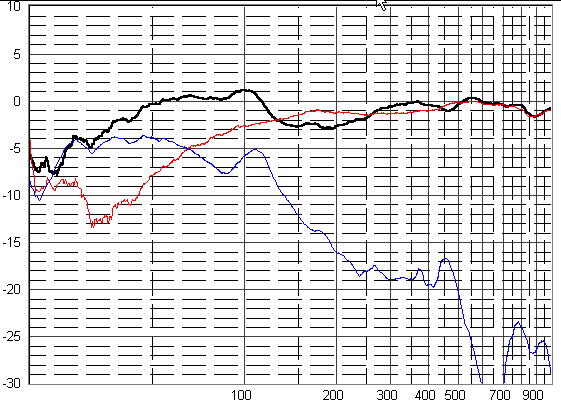
One of the tenets of classic TL theory is that the speed of sound is decreased when passing through a fibrous tangle, i.e., stuffing. There are a number of studies that show the effect and demonstrate that it is frequency dependant. Then there are studies that show that wool is better than Fiberglas�, etc. But wait! Look at this table:
| Length | Taper | F0 | F3 | F5 | F7 | Geometry |
| 60 | 3 | 77 | 180 | 280 | 370 | (So=.01*Sd, Sm=3*Sd) |
| 60 | 2 | 63 | 170 | 270 | 370 | (So=Sd, Sm=3*Sd) |
| 60 | 0 | 53 | 166 | 270 | 375 | (So=Sd, Sm=Sd) |
| 60 | 0 | 52 | 160 | 265 | 370 | (So=3*Sd, Sm=3*Sd) |
| 60 | -2 | 42 | 160 | 260 | 360 | (So=3*Sd, Sm=Sd) |
| 60 | Free Air | 56 | 168 | 280 | 393 | . |
What I did was model each of these geometries, then pick off the resonant points by eye-ball. I used no stuffing in the simulations. Note that the frequency of the fundamental decreases as the taper goes from narrow at the driver end to narrow at the open end. BUT ONLY FOR THE FUNDAMENTAL! The harmonics are virtually unchanged. What this means is that the fundamental frequency of a pipe is dependant upon geometry, and any change in the stuffing is a second order effect. And, the classic TL is reverse tapered, with a physical length shorter than the calculated length. Very interesting.
Ok. you say. Modeling is fine, but what happens in the real world? Look at this table:
| Harmonic | Calculated | Measured | % Difference |
| 1 | 52 | 39 | -33.33 |
| 3 | 156 | 153 | -1.96 |
| 5 | 260 | 267 | 2.62 |
| 7 | 364 | 388 | 6.18 |
| 9 | 468 | 472 | 0.85 |
| 11 | 572 | 589 | 2.89 |
| 13 | 676 | 663 | -1.96 |
| 15 | 780 | 787 | 0.89 |
| 17 | 884 | 851 | -3.88 |
These data were generated from the Peerless Pipe project. Based on the 60" lenght of the pipe, the calculated fundamental frequency is 52Hz. All of the harmonics prove to be close to multiples of 52Hz, EXCEPT for the fundamental. Here again, we have proof that the speed of sound has not changed. The unexpectedly low fundamental is due to pipe geometry.
One final piece of evidence: Here are the bare, unstuffed Peerless pipe and the final stuffed version:


While the stuffed pipe resonant peak is much flattened, it remains near 40Hz.
Beginning with Bradbury, The assumption was that the individual fibers in a fibrous tangle moved with the sound waves, therefore adding moving mass to the air column. More recent experiments indicate that this is not the case. The individual fibers do mot move, and are therefore a pure resistance to the sound waves. The speed of sound is not changed in a fibrous tangle.
Home